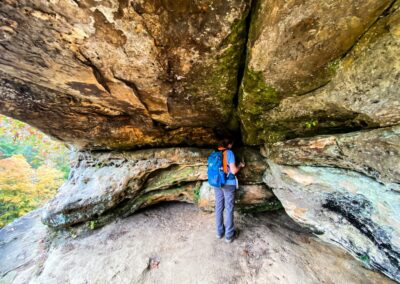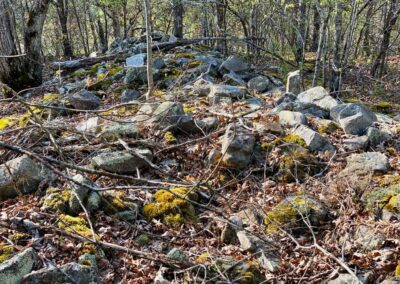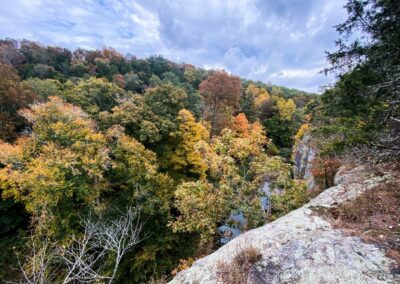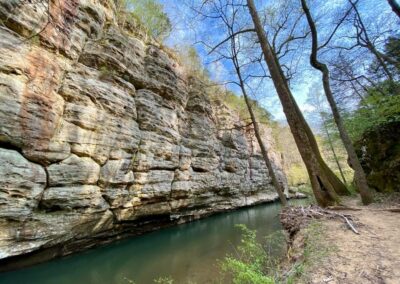Hiking with Shawn’s
Trail Guide Series:
Indian Kitchen
Indian Kitchen is a popular gem in the middle of the Lusk Creek Wilderness that is favored by both hikers and equestrians, alike. Indian Kitchen has so many things to see and do and is even packed with a lot of ancient history. These places don’t get the word ‘Indian’ within their names for no reason. There is always a reason for that particular word to be added into those names and Indian Kitchen is one of those reasons. Since this is only accessed through an official designated wilderness area, only hikers and equestrians may travel to Indian Kitchen. Motor vehicles and bicycles are strictly prohibited from entering a wilderness area. There is an old and much harder way to Indian Kitchen and then there is a much shorter and easier way to the area. This guide will cover both directions because each of them have their own reason for travel.
Indian Kitchen itself is a Natural Area managed by Illinois Department of Natural Resources. The Lusk Creek Wilderness Area and forest around it belongs to the Shawnee National Forest and is managed by the US Forest Service – Hidden Springs Ranger District. There is private property on the other side of the Lusk Creek near the end of the Indian Kitchen Trail as well as near the old trail. Please pay attention to No Trespassing signs and/or purple paint (which means No Trespassing) and abide by such signs to respect the rights of property owners.
Indian Kitchen and the Lusk Creek Wilderness is rugged, and this area is considered moderately difficult. The hike is an out and back hike of about 4 to 6-miles total with max elevation in the 200-foot range. During wet conditions, the trail will likely have damage from horses and mules – this may make hiking the trails a very significant challenge in some areas. Please always yield to equestrians and calmly talk to the riders so that the animals know you are human and not a threat. Venomous copperhead and timber rattlesnakes occur in this area.
Indian Kitchen Area Directions and Trail Information
If traveling by car from Vienna, Illinois: At the HWY-146/HWY-45 intersection, take HWY-146 east (E Vine Street) for 1.5-miles until you reach HWY-147 right after Interstate-24. Turn left (north) onto HWY-147 and travel 12.7-miles to the T intersection for HWY-145. Turn left (north) onto HWY-145 and travel 5.4-miles until you reach Eddyville Blacktop/CR-5 and turn right (east) by the old Shawnee Mart filling station. Travel 0.3-mile and take your first left road (gravel) Indian Kitchen Road. Drive 1.5-miles to reach the Indian Kitchen Trailhead to your left. This road is gravel with some potholes present. Please drive carefully as other people live on and used this road. Use caution during the winter months as this road is rarely treated for snow and ice.
The Indian Kitchen Trailhead has adequate parking for multiple vehicles (at least 6-8). Horse trailers will be a challenge to park at the trailhead. Horse trailers may be better parked on the side of the Indian Kitchen Road near the trailhead. Hayes Canyon Equestrian Campground in Eddyville (a few miles away) may also be a good starting point for trailers. There is one vault toilet restroom at this trailhead that is routinely maintained by the US Forest Service. Please do not throw trash into the toilet and put the lid down after use so it can ventilate properly. There is Information Signage at the trailhead with a map, tips for the area and information on how to report feral pigs. Please report any feral pigs that you see as they are very destructive to the National Forest. Do not attempt to harm, kill or capture any feral pig that you might see. Feral pig eradication activities do occur at times and sections of the wilderness may be closed to the public during that times. Please refer to the US Forest Service Alerts Page for information on any closures that may occur.
The trail to Indian Kitchen starts at the gate across the street from the parking area. Hikers and horseback riders may enter at this point. If you travel down the trail from the main gravel road about 0.2-miles or when you see the Indian Kitchen sign, you will see a very well-worn trail to your right (old trail) and a faint trail to your left (new trail). Let’s go over the trails:
The old trail (right) is longer than the new trail probably by about a mile. This old trail mainly uses an old forest road (or wagon trail) that has been so overused by horses for many years that it remains extremely muddy and torn up most of the year. Don’t take this message as an insult to the equestrian community – that isn’t what it is supposed to be. I am only speaking the truth. It isn’t entirely the equine community’s fault. The old wagon road has a very shaded canopy and much of the road never sees the sun. No erosion control tactics have been put into place along this trail. Because of these issues-moisture is common on the old road and it never dries. I have been out there during a drought and still found parts of the trail with plenty of mud and water. If you take this trail to make the hike longer and it has rained at all, you will get muddy. Wear appropriate footwear (not crocs and flipflops, LOL) and pack plenty of food and water – you will need it.
The new trail (left) is shorter (1.5 to 2-miles to the high line) and less destroyed. However, when wet, because of increase equestrian usage-we have noticed more damage to this trail, but it is nothing like the old trail. The new trail is not on a map or even a designated trail at that. I suggest downloading my Strava Log of when we last hiked the area. We took the new trail and also made part of it somewhat of a loop. While you were able to see the new trail for the most part, some areas were grown up (as of June 2021) so watch where you are traveling
From both trails, you will arrive to a horse high line area where the hiker-only Indian Kitchen trail starts. As stated, this trail is for foot use only at this point. Please use caution if wet, there are rocky areas along the trail that become slick when wet. You will make a short walk down to the canyon and just turn around and follow the trail back to the horse high lines when you are finished. The trail at the bottom of the canyon stops at Lusk Creek.
Indian Kitchen Area Points of Interest Information
The old trail features a trail branch a few miles in (before the wooden Indian Kitchen sign once the road starts turning more into a single-track trail) to your right that will take you to Gilbert Cemetery. There is a big unique sign at the cemetery with a horse rope to try to protect it. The branch trail isn’t very long to the cemetery and you’ll cross a dry rock creek before getting there. I once visited the cemetery on Memorial Day and put US Flags at all the graves. There are some very old and what seem like forgotten graves at this site. The Shawnee National Forest was made up on family farms and communities before it was turned into a National Forest and many of these cemeteries are left behind within it. Please ensure that you respect the graves of those that are laid to rest there.
Along the new trail, from the start you will see an old fence line as well as very large trees and barbed wire. This area was once likely used as a home site and farm. Please be careful if you venture off trail around the larger trees as there are hidden open/unprotected deep wells present. If you continue down the trail for less than a mile, you will notice hardwood trees that are old and grown in a straight line. It is interesting because usually that was only done with pine groves. There are also other home sites, wells, foundations and even a few ponds along the new trail.
Once you get to the Indian Kitchen hiking only trail – the fun really begins!
When you make it down the first hill, note the trail to your right before the registration box. That will take you down to edge the side of the bluff (safe if you walk carefully) to a shelter that looks over Lusk Creek. That shelter is the Indian Kitchen! It is said that Native Americans were believed to have used that shelter to cook in. Any carvings you find are modern and not Native American. Please don’t add to that graffiti.
The registration box is where people like to sign their names when they visit. Check it out but be careful as wasps tend to nest in there from time to time. I try to leave a few Hiking with Shawn stickers in there each time I visit. I notice people always take them too which makes me smile.
Shortly after the registration box, you will notice a rocky spot on the trail that looks like a wall or flattened pile of rocks on both sides – this is a Native American stone wall or often called Stone Fort. No one really knows for sure that they were used for, but they are scattered all around the region.
If you go to the very bottom (be careful climbing up and down), you will reach Lusk Creek and the bluffage. If there is a waterfall present, note that one year when it was covered in ice, people ice climbed it! People also swim in the creek right there as well. Whatever you decide to do, please be safe and use common sense.
There are many fun activities at Indian Kitchen so you might want to leave early enough to be able to explore it all!
Indian Kitchen Area Safety and Important Information
Indian Kitchen is in the middle of Lusk Creek Wilderness, so it is appropriate to assume the trails there are rugged. A wilderness area isn’t an easy walk in the park. Appropriate footwear, gear, food, and water is required. If you go hiking in this area with crocs and a half naked Barbie, you are suicidal to say the least and probably should be outdoors. That meme is going to get people killed. When hiking anywhere in Lusk Creek Wilderness – you can expect rough trail, overgrown during the warmer months, ticks and other biting insects, spider webs galore, mud, rocky areas, venomous copperhead and timber rattlesnakes, steep edges, slippery areas and fall hazards. On top of that, its remoteness makes it difficult for search and rescue to get to you quickly if you need them and forget about cell phone reception. I don’t say all this to discourage people from recreating in the wilderness, I say it to tell the truth about what a wilderness is meant to be. If you want something easy, this place isn’t for you but if you don’t mind a rugged adventure, then you should defiantly check it out.
Most hazards in this area will be found off trail. Expect a lot of poison ivy off trail and stinging nettle around the moister areas. Venomous snakes will most likely be found off trail but from time to time, they will probably be on the trail. It is illegal to collect, harm or kill a venomous snake in a National Forest. To avoid a negative interaction with them, leave them alone and move away with some distance. Snakes won’t chase you and they don’t want to bite you because they’re terrified of you. Most people who fall in the area do so when they get off trail and don’t watch their step. Always watch your next step to avoid danger. It is really that simple! The closest hospital is in Harrisburg and emergency response in this area is done by volunteer rural county departments. Response times could be several hours. Make sure you tell someone where you are going beforehand and try not to hike alone.
Horseback riding is extremely popular in this area. It is likely that hikers will encounter horseback riders anywhere in Lusk Creek Wilderness. Horses are often scared of hikers because they don’t know what we are at first and think we might be there to harm them. So, if you see a horseback rider, always yield to them. Horseback riders always have the right-of-way because of the fact that the horse has a mind of its own. Don’t just stand still and not talk though otherwise the horse will really freak out. Instead, talk in a calm and friendly manner to the rider so the horse realized you’re just another human. Check out my Sharing the Shawnee with Equestrians article for even more tips. And remember, without the horses, most of the trails wouldn’t exist.
One more thing about horses and their riders… they make wonderful spider web catchers. I recommend letting them go first so they can take down all the spider webs. And then all you have to do is dodge poop and mud which is way easier than doing the funky chicken dance every time you get into a spider web. Godspeed horseback riders, I love you for your web take down tactics even if you’re not exactly on board. One other tip for avoiding webs is to hike with me if you ever have the chance – I’m 6’5” tall and usually always lead the hike. I get all the spider webs it seems.
Other Things to Do in the Indian Kitchen Area
After a long hike at Indian Kitchen, it is always a favored trip to go get a burger, fried mushrooms, and sweet tea from Shotgun Eddy’s in Eddyville. If you want an adult beverage, they got that too! Please remember to drink responsibly! The Chocolate Factory near Golconda has wonderful chocolate treats and ICE CREAM! And afterwards, you can go across the street to Dixon Springs State Park and hike off all the sweets. While in Golconda, check out Diver Down and the Dairy Bar for other good food as well.
Nearby to Indian Kitchen are many different lodging options including Hayes Canyon Campground for equestrian camping. The Hangout Campground in Eddyville is good for electrical hookups, cyclists, and hikers such as those through hiking the River to River Trail. For dispersed camping – I recommend the Lusk Creek Wilderness itself. Check out my Wilderness Guide for camping information and rules when camping in Designated Wilderness Areas. Red Bud Campground at Bell Smith Springs is good for tent camping as well and you have plenty of hiking trails there, too!
For things to do in this area – Check out Hayes Creek Canyon and Jackson Hole for rugged hiking adventures. Millstone Bluff would be the best easier hiking trip in the area. The Lusk Creek Access is great for launching a kayak or canoe into Lusk Creek. Lake Glendale has a designated mountain bike trail which is loads of fun. Visit Harrisburg for various entertainment options including the Tunnel Hill State Trail, shopping options and Bigfoot Lore! While you’re in Harrisburg, check out Mackies Pizza, our favorite pizza place.
Watch the videos for this trail!
Below is a recent video that we filmed while enjoying this area.
One last thing!
Filming the videos, taking the photos, editing everything and writing this article takes time and it’s all provided for free. Consider making a small monthly contribution to Hiking with Shawn by becoming an official Patreon supporter on Hiking with Shawn! You can also support us by purchasing official merch from the Hiking with Shawn online store. Lastly, please share this article and our videos and follow us on YouTube, Facebook, Twitter, Instagram and Tumbler for more free guides, videos, photos, contests and more!
Thanks for checking out this guide and please share it with others if you’d like to see more of them made!
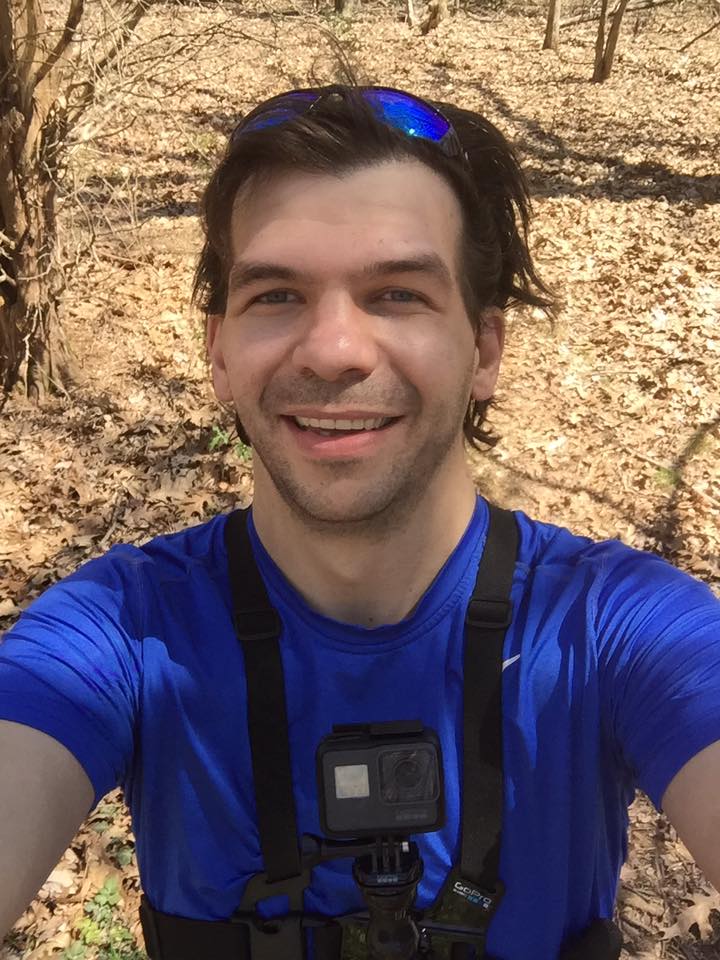
Shawn J. Gossman
Host
Shawn is the founder and host of the YouTube Channel, Hiking with Shawn as well as Hiking with Shawn LLC. Shawn hikes, backpacks and visits various forested areas in the Shawnee National Forest, local state parks and other areas promoting outdoor recreational activities to obtain video to show to locals and non-locals alike. Please support Shawn’s efforts by sharing this post and leaving a comment below.

